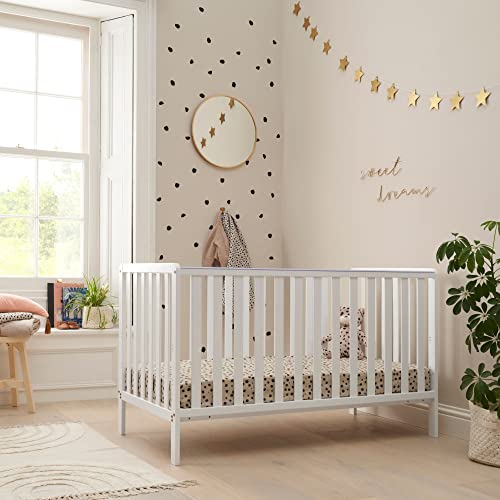What Is The Best Place To Research White Cot Beds With Organic Materials Online

White Cot Beds with Organic Materials: An In-Depth Guide for Parents
In an age where the awareness surrounding sustainable living is on the increase, going with organic materials for children's furniture, especially cot beds, has amassed significant attention among parents. This article provides a helpful introduction of white cot beds made with organic materials, their advantages, and what to think about when picking the ideal cot bed for your baby.
What Are Organic Cot Beds?
Organic cot beds are developed with the wellness of babies in mind, constructed from materials that are grown and processed without using hazardous chemicals, pesticides, or synthetic additives. The main focus is to develop a safe and non-toxic environment for babies, whose immune systems are more susceptible than grownups.
Common Organic Materials Used in Cot Beds
- Organic Cotton: Grown without pesticides or fertilizers, organic cotton is soft and breathable. It is typically used in mattress covers, bed linen, and certain cot structures.
- Bamboo: A sustainable resource, bamboo is naturally anti-bacterial and moisture-wicking. It is typically used for fabrics, providing a soft touch for babies.
- Wool: Naturally hypoallergenic, organic wool assists control temperature and wick away moisture.
- Solid Wood: Many organic cot beds are made from sustainably sourced solid wood, such as maple or beech, which is free from harmful glues and surfaces.
- Natural Latex: Used in mattresses, natural latex is stemmed from rubber trees and is durable and helpful while remaining without harmful chemicals.
Benefits of Choosing Organic Cot Beds
- Security for Baby: Organic cot beds are devoid of unstable organic substances (VOCs) and hazardous chemicals frequently found in conventional furnishings.
- Comfort: The breathable materials and materials utilized in organic cot beds can boost sleep quality for babies.
- Environmental Impact: Choosing organic materials promotes sustainable farming and responsible forestry practices.
- Long-lasting Quality: Organic cot beds typically feature top quality craftsmanship, equating into toughness and a longer life expectancy.
Comparison of Organic and Conventional Cot Beds
| Feature | Organic Cot Beds | Standard Cot Beds |
|---|---|---|
| Material Safety | Non-toxic; devoid of chemicals | May include VOCs and contaminants |
| Convenience | Breathable and hypoallergenic | Varies; may include synthetic materials |
| Ecological Impact | Sustainable and eco-friendly | Frequently non-sustainable |
| Resilience | Usually premium | Differs; might be less long lasting |
| Cost | Usually higher | More budget-friendly |
What to Look for When Purchasing an Organic Cot Bed
When searching for a white cot bed made from organic materials, it's essential to consider several elements to ensure you make an educated option:
- Certifications: Look for accreditations that guarantee organic materials, such as GOTS (Global Organic Textile Standard) for materials and FSC (Forest Stewardship Council) for wood.
- Mature Design: Ensure the cot bed has a fully grown design that can adapt as your kid grows (e.g., switching from a cot to a toddler bed).
- Ease of Cleaning: Babies can be unpleasant, so think about detachable and washable covers for benefit.
- Safety Compliance: Check that the cot bed meets regional security standards (e.g., safety slats, stable construction).
- Aesthetic appeals and Décor: A white cot bed can fit different nursery themes, so think about designs that match your decor.
Popular Brands Offering Organic Cot Beds
A number of brand names focus on environment-friendly and organic cot beds. A few of these noteworthy brands include:
- Naturepedic: Known for their organic bed mattress and bedding, they offer cot beds that focus on kid safety and environmental sustainability.
- Kalon Studios: Offers stylish, modern cot beds made from sustainably-sourced wood.
- Silver Cross: Features traditional cot beds made from organic materials and created with safety and performance in mind.
- Babyletto: Combines modern design and environment-friendly practices, using different organic and sustainable baby furniture.
Frequently Asked Questions About Organic Cot Beds
1. Are organic cot beds more expensive than routine cot beds?Yes, organic cot beds typically come at a greater price point due to the quality of materials and sustainable practices involved in their production.
2. How do I keep an organic cot bed?Regular cleaning with natural detergents, periodic vacuuming, and using protective covers can assist keep your organic cot bed. 3. What are the indications of a poor-qualitycot bed?Signs include instability, an inadequately completed surface
, off-gassing smells, and threat of injury due to sharp edges. 4. Can I find affordable organic cot beds?Yes, while organic cot beds can be costlier, numerous brand names provide economical alternatives. Shopping throughout sales or exploring pre-owned stores can likewise be advantageous. 5. How typically should I replace my baby's cot mattress?It is suggested to change the mattress every 3-5 years or when it reveals signs of wear, drooping, or if the baby starts to sleep less comfortably. Selecting a white cot bed made from organic materials not just supports your baby's health however also lines up with sustainable practices that benefit the world. As White Wooden Cot Beds With Storage look for furnishings that supplies a safe and environment-friendly environment for their children, investing in organic alternatives becomes an accountable option. By educating themselves on functions, materials, and brand names, moms and dads can make sure that they are making a decision that prioritizes their child's well-being and the world's future.

